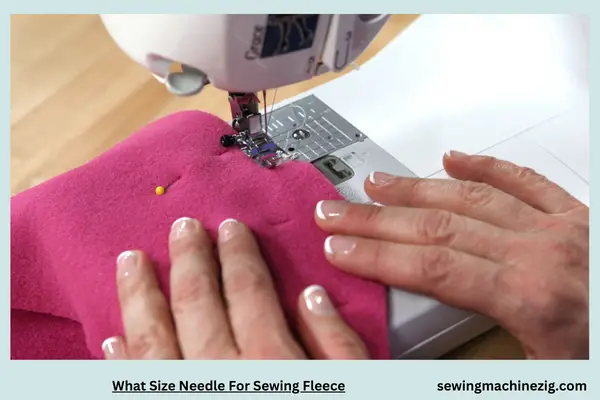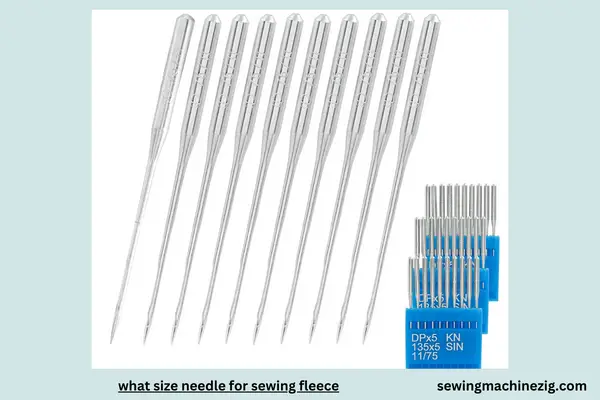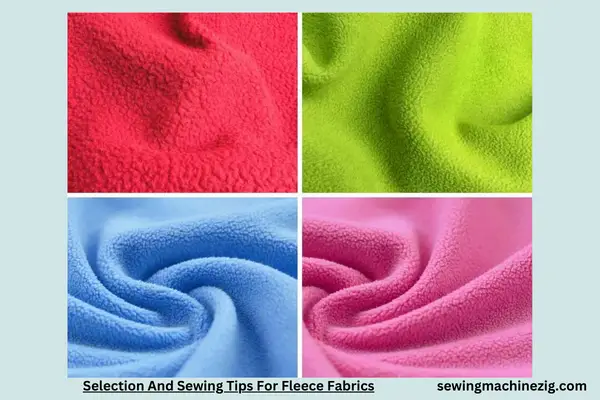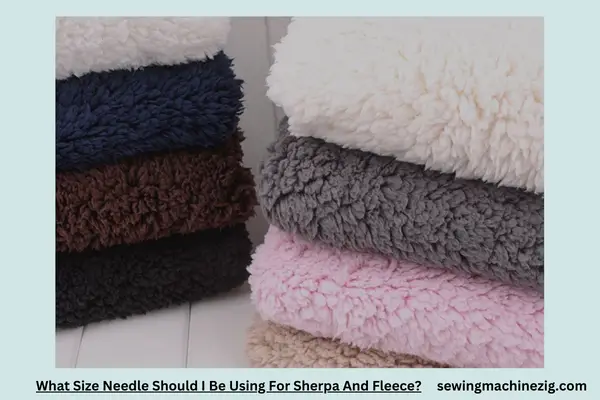
Navigating the world of fleece sewing demands precision, and the right needle is your compass. “What Size Needle for Sewing Fleece” is your guide to seamless stitching through this cozy fabric. As you embark on projects to snuggle-worthy blankets or warm garments, choosing the correct needle size becomes paramount.
In this exploration, we demystify the needle selection process, ensuring your sewing machine glides effortlessly through the fleece. Whether you’re a crafting enthusiast or a seasoned seamstress, join us as we unravel the nuances of needle sizes, unlocking the key to flawless fleece creations.
What Size Needle For Sewing Fleece Detailed Answer

Sewing fleece demands precision, and choosing the correct needle size is paramount for a smooth and successful project.
In this comprehensive guide on “What Size Needle for Sewing Fleece,” we’ll walk you through the steps to ensure your needle is perfectly matched to this cozy fabric, enhancing both your efficiency and the quality of your final product.
Step 1: Understand Fleece Characteristics
Fleece, known for its soft and fuzzy texture, requires a needle that can penetrate the fabric without causing snags or damage. Recognizing the unique properties of fleece sets the stage for needle selection.
Step 2: Consult Your Sewing Machine Manual
Refer to your sewing machine manual for guidance on compatible needle sizes. Manufacturers often provide recommendations based on the machine’s capabilities and the intended fabric.
Step 3: Choose the Right Needle Type
Opt for a ballpoint or stretch needle when sewing fleece. These needle types have rounded tips, minimizing the risk of piercing the fabric and causing unsightly holes.
Step 4: Consider Fabric Weight
Evaluate the weight of your fleece fabric. For lightweight fleece, a smaller needle size (e.g., 70/10 or 80/12) is suitable, while heavier fleece may require a larger needle (90/14 or 100/16).
Step 5: Test with Scrap Fabric
Before starting your main project, conduct a test on a scrap piece of fleece using different needle sizes. This allows you to observe how each needle performs and choose the one that produces the cleanest stitches without causing puckering.
Step 6: Assess Stitch Quality
Examine the stitches on the test fabric. The right needle size should create even and secure stitches without causing the fleece to stretch or distort.
Step 7: Check for Needle Heat
Sewing fleece at high speeds may generate heat, potentially leading to skipped stitches. If you encounter this issue, consider switching to a larger needle to dissipate heat more effectively.
Step 8: Adjust Tension if Necessary
Fine-tune your sewing machine’s tension settings to complement the chosen needle size. Proper tension ensures the stitches lie flat on the fleece without creating unnecessary bulk.
Step 9: Choose Needle Size for Additional Layers
If your project involves multiple layers of fleece, such as in quilting, opt for a slightly larger needle size to accommodate the extra thickness. This prevents the needle from struggling to penetrate the fabric layers.
Step 10: Keep Spare Needles
Have spare needles on hand, especially if you’re working on extensive fleece projects. Needles can become dull over time, affecting stitch quality, so it’s beneficial to replace them periodically.
Step 11: Maintain a Consistent Stitch Length
Regardless of the needle size, maintaining a consistent stitch length is crucial for a professional-looking finish. Adjust your machine settings accordingly to achieve uniform stitches.
By following these detailed steps on “What Size Needle for Sewing Fleece,” you’ll not only enhance your understanding of needle selection but also ensure that your sewing machine and fleece fabric work in perfect harmony, resulting in flawless and cozy creations.
Selection And Sewing Tips For Fleece Fabrics

Certainly! Working with fleece fabrics can be a cozy and enjoyable experience. Here are some easy-to-follow selection and sewing tips:
Selection Tips:
Choose Quality Fleece:
- Look for high-quality fleece with a soft texture. Opt for anti-pill fleece to prevent the formation of little balls on the fabric surface over time.
Consider the Weight:
- Fleece comes in various weights. Select the weight that suits your project. Lighter weights are great for blankets, while heavier weights work well for outerwear.
Check Stretch Direction:
- Fleece often has a stretch in one direction. Pay attention to the stretch direction and align it with your pattern for better fit and comfort.
Explore Patterns:
- Choose patterns that are suitable for fleece projects. Simple designs with fewer seams work well, especially for beginners.
Pre-Wash Fleece:
- Consider pre-washing your fleece to remove any sizing and to allow for shrinkage. Check the care instructions on the fabric bolt before washing.
Sewing Tips:
Use a Walking Foot:
- A walking foot helps feed the fleece through the machine evenly, preventing stretching or distortion of the fabric.
Use Ballpoint or Stretch Needles:
- Opt for ballpoint or stretch needles. These needles are designed for knit fabrics like fleece and help prevent snags and damage.
Adjust Stitch Length:
- Use a slightly longer stitch length than you would for woven fabrics. A longer stitch length helps prevent puckering and provides a cleaner finish.
Experiment with Tension:
- Test the tension on a scrap piece of fleece before starting your project. Adjust the tension as needed to ensure even stitches.
Consider Using a Walking Foot:
- If you’re working with thick or multiple layers of fleece, a walking foot can help feed the fabric evenly through the machine.
Practice with Scrap Fabric:
- Before sewing your main project, practice on scrap fleece to get a feel for how the fabric behaves and to adjust your machine settings accordingly.
Use Clips Instead of Pins:
- Instead of traditional straight pins, use clips to hold the
fabric together . The fleece is thick, and clips are less likely to distort the fabric.
Finish Edges:
- Fleece doesn’t fray, but finishing edges with a serger or a zigzag stitch can add a polished look to your project.
Avoid Ironing Directly:
- Fleece can melt when exposed to high heat. Avoid ironing directly on the fabric. If needed, use a pressing cloth or iron on a lower setting.
Consider Double-Sided Fleece:
- If you’re making a reversible project, consider using double-sided fleece. This eliminates the need for a lining and provides a finished look on both sides.
By following these easy tips, you’ll be well on your way to successfully sewing with fleece fabrics, creating cozy and warm projects with ease.
What Size Needle Should I Be Using For Sherpa And Fleece?

Selecting the right needle size for sewing with Sherpa and fleece is crucial for achieving clean and effective stitches. Here’s an easy explanation:
Understand Fabric Characteristics:
- Sherpa and fleece are plush, soft fabrics with some thickness. Understanding the characteristics of these fabrics will guide your needle choice.
Choose a Ballpoint Needle:
- Opt for a ballpoint needle, also known as a jersey needle. These needles have rounded tips, which help prevent snags and damage to the fabric fibers.
Consider the Fabric Weight:
- Take into account the weight of your sherpa or fleece. For lightweight fleece, a smaller needle size like 70/10 or 80/12 may be suitable. For heavier fleece or sherpa, consider a larger needle, such as 90/14 or 100/16.
Test on Scrap Fabric:
- Before starting your main project, conduct a test on a scrap piece of sherpa or fleece. This allows you to observe how different needle sizes perform on your specific fabric.
Evaluate Stitch Quality:
- Examine the stitches on the test fabric. The right needle size should produce even and secure stitches without causing the fabric to stretch or distort.
Consider the Sewing Machine Manual:
- Refer to your sewing machine manual for guidance on needle sizes. Manufacturers often provide recommendations based on the machine’s capabilities and the intended fabric.
Adjust Needle Size for Layers:
- If your project involves multiple layers of sherpa or fleece, such as in quilting, you might need a slightly larger needle to accommodate the extra thickness. This prevents the needle from struggling to penetrate the layers.
Maintain a Consistent Stitch Length:
- Regardless of the needle size, maintaining a consistent stitch length is crucial for a professional-looking finish. Adjust your machine settings accordingly.
Check Needle Quality:
- Ensure that your needle is sharp and in good condition. A dull needle can cause skipped stitches and fabric damage.
Keep Spare Needles:
- Have spare needles on hand, especially if you’re working on extensive sherpa or fleece projects. Needles can become dull over time, affecting stitch quality, so it’s beneficial to replace them periodically.
By considering the characteristics of your fabric, testing on scrap material, and choosing an appropriate needle size, you’ll be able to sew with sherpa and fleece more effectively, resulting in high-quality and professional-looking projects.
Conclusion
In conclusion, What Size Needle for Sewing Fleece, Selecting the right needle size is paramount for sewing fleece with precision and ease. The ideal needle, such as a ballpoint or jersey needle, prevents snags and ensures smooth stitches. Tailoring the needle size to the fleece weight and considering the sewing machine’s specifications enhances the overall sewing experience.
Remember, testing on scrap fabric and maintaining needle quality are key practices for achieving optimal results. So, when wondering, “What Size Needle for Sewing Fleece?”—consider the fabric weight and machine guidelines for a seamless sewing journey.
FAQS
Q1: What size needle is recommended for sewing fleece fabric?
A1: For sewing fleece, it’s advisable to use a larger needle size to accommodate the fabric’s thickness. A size 90/14 or 100/16 needle is commonly recommended. This prevents the needle from bending or breaking and ensures smooth stitches through the dense fleece fibers.
Q2: Can I use a smaller needle size for lightweight fleece?
A2: Yes, for lightweight fleece, a smaller needle size like 70/10 or 80/12 may be appropriate. It’s essential to match the needle size to the fabric weight to achieve optimal stitching results. Experiment with different sizes on a scrap piece to determine the best fit for your specific fleece.
Q3: What happens if I use the wrong needle size for sewing fleece?
A3: Using a needle that’s too small may result in skipped stitches, fabric puckering, or breakage. Conversely, a needle that’s too large might leave noticeable holes in the fleece. It’s crucial to select the right needle size to ensure a smooth sewing process and a professional-looking finish.
Q4: Can I use a universal needle for sewing fleece?
A4: While universal needles can handle various fabrics, it’s recommended to use a needle specifically designed for knit fabrics when sewing fleece. A ballpoint or stretch needle is ideal as it prevents snags and provides better penetration through the fleece fibers. “What Size Needle for Sewing Fleece“
Q5: How do I know if my needle is suitable for sewing thick or double-layered fleece?
A5: When working with thick or double-layered fleece, opt for a larger needle size, such as 100/16. This size accommodates the additional thickness, preventing the needle from struggling and ensuring smooth stitching through multiple layers of fleece. “What Size Needle for Sewing Fleece“
Q6: Can I use the same needle for different types of fleece fabric?
A6: It’s advisable to consider the weight and thickness of the specific fleece you’re working with. For heavier or thicker fleece, choose a larger needle. For lightweight fleece, a smaller needle may be more appropriate. Always test on a scrap piece to confirm the needle’s suitability for your particular fleece fabric. “What Size Needle for Sewing Fleece“
Q7: How often should I change the needle when sewing fleece?
A7: To maintain optimal sewing performance, it’s recommended to change the needle before starting a new fleece project or after every 8-10 hours of sewing. A fresh needle ensures cleaner stitches and reduces the risk of fabric damage or distortion. “What Size Needle for Sewing Fleece“



